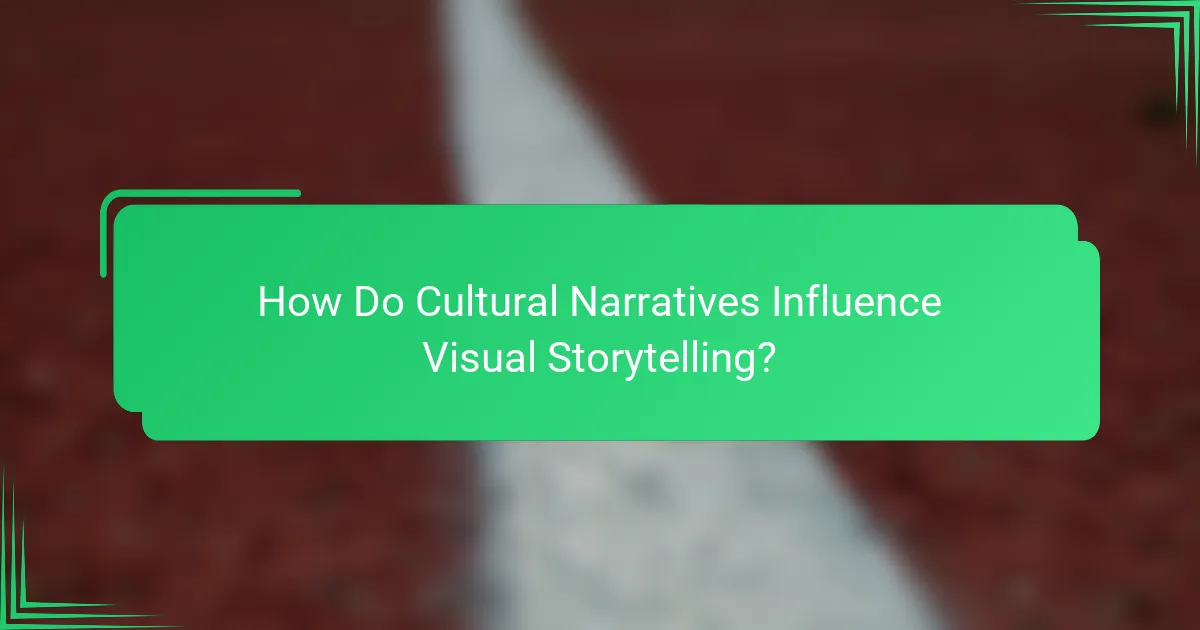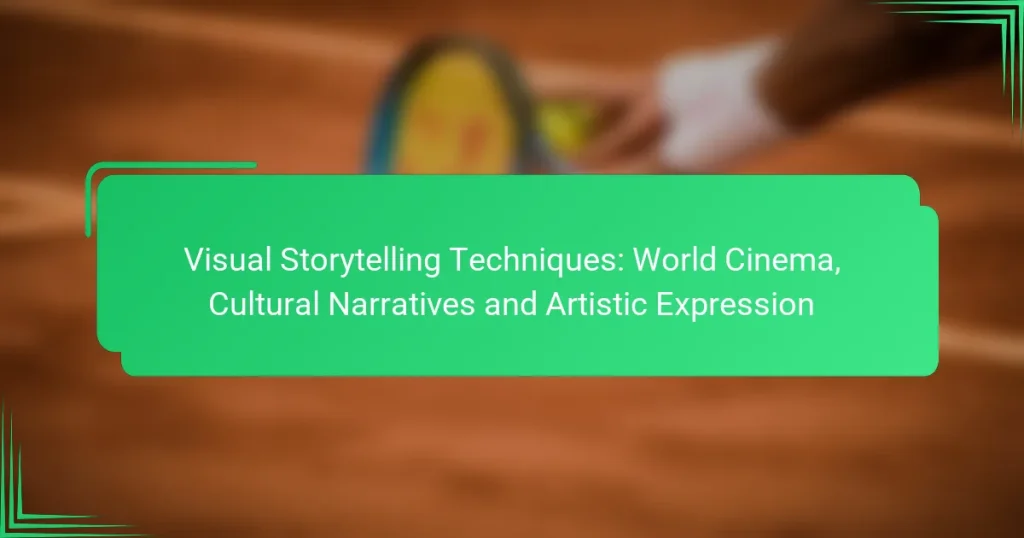Visual storytelling techniques in world cinema play a vital role in enhancing narrative depth and emotional engagement. By incorporating elements such as symbolism, color theory, and innovative cinematography, filmmakers can create rich cultural narratives that resonate with audiences. These artistic expressions not only shape the way stories are told but also deepen the viewer’s connection to the characters and themes presented on screen.

What Are Effective Visual Storytelling Techniques in World Cinema?
Effective visual storytelling techniques in world cinema enhance narrative depth and emotional resonance. These techniques include the use of symbolism, color theory, framing and composition, character arcs, and sound design integration, each contributing uniquely to the storytelling process.
Use of Symbolism
Symbolism in visual storytelling conveys deeper meanings beyond the surface narrative. Objects, colors, or actions can represent broader themes, such as love, loss, or cultural identity. For example, a recurring motif like a broken mirror might symbolize fractured relationships or self-perception.
To effectively use symbolism, filmmakers should ensure that symbols are culturally relevant and resonate with the audience. This can enhance engagement and provoke thought, making the story more impactful.
Color Theory
Color theory plays a crucial role in setting the mood and tone of a film. Different colors evoke specific emotions; for instance, red can signify passion or danger, while blue often conveys calmness or sadness. Filmmakers can use color palettes strategically to reflect character emotions or thematic shifts.
When applying color theory, consider the cultural connotations of colors, as they can vary significantly across different societies. A well-chosen color scheme can unify scenes and strengthen the overall narrative.
Framing and Composition
Framing and composition determine how scenes are visually structured, influencing audience perception. Techniques such as the rule of thirds, leading lines, and symmetry guide the viewer’s focus and enhance storytelling. For instance, an off-center subject can create tension or highlight isolation.
Filmmakers should experiment with different angles and perspectives to convey emotions effectively. Avoid cluttered frames that distract from the main subject, as simplicity often leads to stronger visual narratives.
Character Arcs
Character arcs illustrate the transformation of characters throughout the film, making them relatable and engaging. A well-developed arc typically includes a clear goal, conflict, and resolution, allowing audiences to connect emotionally with the characters’ journeys.
To create compelling character arcs, ensure that characters face meaningful challenges that lead to growth. This can involve internal struggles or external conflicts, which should resonate with the cultural context of the story.
Sound Design Integration
Sound design integration enhances the emotional impact of visual storytelling by complementing the visuals. Effective use of sound effects, ambient noise, and music can heighten tension, evoke nostalgia, or create a sense of place. For example, the sound of rain can signify sadness or reflection.
When integrating sound design, consider how audio elements interact with visuals. Avoid overwhelming the audience with excessive sound; instead, aim for a balanced mix that supports the narrative without overshadowing it.

How Do Cultural Narratives Influence Visual Storytelling?
Cultural narratives significantly shape visual storytelling by providing context, themes, and symbols that resonate with audiences. These narratives inform the way stories are told, influencing everything from character development to visual aesthetics, ultimately enriching the viewer’s experience.
Representation of Local Myths
Local myths serve as a foundation for visual storytelling, offering rich symbolism and themes that reflect cultural values. Filmmakers often incorporate these myths to create relatable narratives that resonate deeply with local audiences. For example, a film set in Japan might draw on Shinto beliefs, using nature and spirits to convey messages about harmony and respect.
When integrating local myths, it’s essential to understand their nuances and meanings. Misrepresentation can lead to cultural insensitivity, so filmmakers should engage with local communities to ensure authenticity.
Impact of Historical Context
Historical context plays a crucial role in shaping visual narratives, as it influences the themes and conflicts presented in films. For instance, movies set during significant events, such as wars or revolutions, often reflect the societal struggles and triumphs of that time. This can create a powerful emotional connection for viewers who share that history.
Filmmakers should consider the historical backdrop of their stories, ensuring that they accurately depict the events and their impact on the culture. This not only enhances the story’s authenticity but also educates audiences about the past.
Use of Traditional Art Forms
Incorporating traditional art forms into visual storytelling can enrich the narrative and provide a unique aesthetic. Techniques such as indigenous painting styles, dance, or music can be woven into the film’s visuals and soundscapes, creating a multisensory experience that honors cultural heritage.
To effectively use traditional art forms, filmmakers should collaborate with local artists and cultural experts. This partnership can help ensure that the representation is respectful and accurate, avoiding stereotypes while celebrating the richness of the culture.

What Are the Key Elements of Artistic Expression in Film?
Artistic expression in film encompasses various elements that contribute to storytelling, emotional impact, and aesthetic appeal. Key components include visual aesthetics, innovative cinematography, and editing techniques, each playing a crucial role in how narratives are conveyed and experienced by audiences.
Visual Aesthetics
Visual aesthetics refer to the overall look and feel of a film, including color palettes, composition, and set design. These elements work together to create a specific mood or atmosphere that enhances the narrative. For instance, a film set in a dystopian future might use desaturated colors and stark contrasts to evoke feelings of despair.
When considering visual aesthetics, filmmakers should think about how each visual choice aligns with the story’s themes. A well-coordinated aesthetic can significantly influence audience perception and emotional engagement. For example, vibrant colors in a romantic comedy can uplift the mood, while muted tones in a drama can deepen emotional resonance.
Innovative Cinematography
Innovative cinematography involves the use of creative camera techniques and angles to tell a story visually. Techniques such as tracking shots, aerial views, and unique framing can provide fresh perspectives and enhance narrative depth. For example, a long take can create a sense of real-time urgency, immersing viewers in the action.
Filmmakers should experiment with different lenses and camera movements to find the best way to convey their story. Using a wide-angle lens can create a sense of intimacy in a close-up scene, while a telephoto lens can compress space and heighten tension. Understanding the impact of these choices is vital for effective storytelling.
Editing Techniques
Editing techniques shape the pacing and flow of a film, influencing how the story unfolds. Techniques such as cross-cutting, jump cuts, and montage can create tension, emphasize themes, or provide context. For instance, cross-cutting between two parallel storylines can build suspense and keep viewers engaged.
When editing, filmmakers should consider the rhythm of the film and how each cut contributes to the overall narrative. Maintaining a balance between fast-paced sequences and slower moments can enhance emotional impact. It’s essential to avoid over-editing, which can confuse viewers and detract from the story’s clarity.

How Can Filmmakers Enhance Audience Engagement?
Filmmakers can enhance audience engagement by utilizing techniques that foster interaction and emotional connection. By incorporating elements like interactive storytelling and emotional resonance, filmmakers can create immersive experiences that captivate viewers and encourage deeper investment in the narrative.
Interactive Storytelling
Interactive storytelling allows audiences to influence the narrative direction, creating a more personalized viewing experience. This can be achieved through branching storylines, viewer choices, or multimedia elements that invite participation.
For instance, films or series that offer alternate endings based on audience votes or interactive platforms like Netflix’s “Bandersnatch” exemplify this approach. Filmmakers should consider the balance between interactivity and narrative coherence to maintain engagement without overwhelming viewers.
Emotional Resonance
Emotional resonance is crucial for connecting with audiences on a personal level, making them feel invested in the characters and story. Techniques such as relatable character arcs, poignant dialogue, and evocative visuals can evoke strong feelings and enhance viewer attachment.
Filmmakers can use music, pacing, and visual metaphors to amplify emotional moments. For example, a well-timed score can heighten tension or joy, while visual motifs can symbolize themes, deepening the audience’s emotional experience. Prioritizing authenticity in storytelling will help ensure that the emotional impact feels genuine and relatable.

What Are the Best Practices for Integrating Cultural Narratives?
Integrating cultural narratives effectively requires a deep understanding of the local context and a commitment to authenticity. Best practices involve thorough research, collaboration with local creators, and a respectful representation of the culture being portrayed.
Researching Cultural Context
Understanding the cultural context is crucial for authentic storytelling. This involves exploring the history, traditions, and values of the community you are representing. Utilize resources such as academic articles, documentaries, and interviews with local experts to gain insights.
Consider the nuances of cultural symbols and practices, as misrepresentation can lead to stereotypes. Engaging with community members can provide invaluable perspectives that enrich your narrative and ensure it resonates with the intended audience.
Collaborating with Local Artists
Partnering with local artists can enhance the authenticity of your project. These artists bring firsthand knowledge and experience that can inform your storytelling approach. Look for opportunities to involve them in various stages of production, from scriptwriting to visual design.
Collaboration fosters a sense of ownership and respect for the culture being depicted. Establish clear communication and mutual goals to ensure that the partnership is beneficial for both parties. This approach not only enriches the narrative but also supports local talent and promotes cultural exchange.


